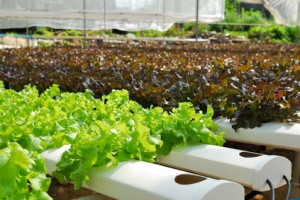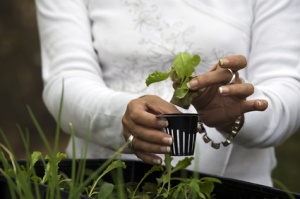 Hydroponic gardening comes in two forms – but both make it possible to grow plants without the use of soil. Generally speaking, there are two types of hydroponic gardening systems: passive and active. The term refers to the type of nutrient system used. Active systems typically result in healthier and faster grow, but are harder to set up and maintain than a passive system. Hydroponic gardening systems may also be characterized as either recovery or non-recovery systems, based on whether or not the nutrients are recovered after use.
Hydroponic gardening comes in two forms – but both make it possible to grow plants without the use of soil. Generally speaking, there are two types of hydroponic gardening systems: passive and active. The term refers to the type of nutrient system used. Active systems typically result in healthier and faster grow, but are harder to set up and maintain than a passive system. Hydroponic gardening systems may also be characterized as either recovery or non-recovery systems, based on whether or not the nutrients are recovered after use.
What is a Passive System?
A passive system uses a capillary or a wick system to deliver nutrition to plant roots. Nutrients, housed in a fluid solution are drawn up and absorbed through a growing medium and passed to the plant roots.
The passive system is easiest to set up and maintain because it has no moving parts or pumps. However, the plant’s roots are wet on a continual basis. The wetness prevents oxygen from flowing in the best way possible, which is required to get the best plant growth. Passive systems are typically non-recovery systems, because there is no way to recover the nutrients the plant does not directly absorb. As such, it is not the recommended approach to hydroponic gardening.
What is an Active System?
An active system relies on pumps or other mechanics to move the nutrient solution to the roots. As such, you can reuse nutrients, making active systems also recovery systems. Active systems allow for the control of nutrient flow, which makes it easier to manipulate the nutrients around the roots. This allows for optimal oxygen absorption to promote stronger and healthier plant growth.
 An ebb and flow system is the most popular choice for active recovery hydroponic gardening systems. The nutrient solution is housed in the bottom, underneath a tray that holds the plants. A timed pump sends nutrients to the plant roots, and then allows it to drain back into the tray. The system gives the plants their nutrition, keeps them from being constantly wet, and pulls fresh oxygen to the roots. The roots dry out between cycles, which helps keep the plants healthy and strong.
An ebb and flow system is the most popular choice for active recovery hydroponic gardening systems. The nutrient solution is housed in the bottom, underneath a tray that holds the plants. A timed pump sends nutrients to the plant roots, and then allows it to drain back into the tray. The system gives the plants their nutrition, keeps them from being constantly wet, and pulls fresh oxygen to the roots. The roots dry out between cycles, which helps keep the plants healthy and strong.
Though the ebb and flow system is not as simple as a wick based system. However, it is easy to set up and affordable to maintain, making it a great choice for even the beginner hydroponics gardener.
It is also possible to grow plants using vertical hydroponics. This approach allows you to grow more plants without increasing the amount of space required to house the garden. The largest and heaviest plants are placed at the bottom of the system, while the lighter plants are placed on top. Vining plants can be trained to grow up the rack or a support, to save even more space.
Hydroponic gardening is an easy and cost effective way to maintain a garden, especially in areas where outdoor gardening is not a practical solution. Using this method, you can grow great tasting food with an environmentally friendly system.
